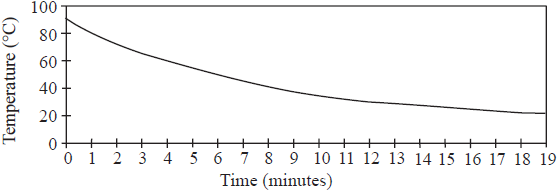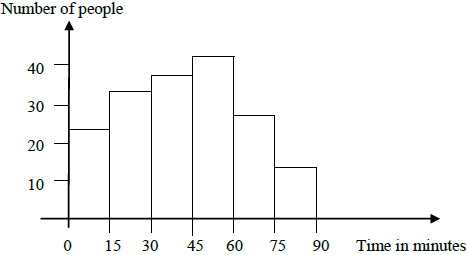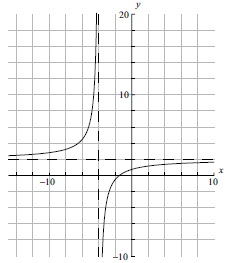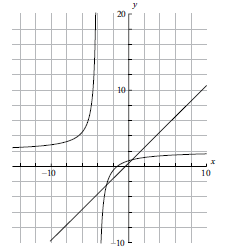Question
Jenny has a circular cylinder with a lid. The cylinder has height 39 cm and diameter 65 mm.
An old tower (BT) leans at 10° away from the vertical (represented by line TG).
The base of the tower is at B so that \({\text{M}}\hat {\rm B}{\text{T}} = 100^\circ \).
Leonardo stands at L on flat ground 120 m away from B in the direction of the lean.
He measures the angle between the ground and the top of the tower T to be \({\text{B}}\hat {\rm L}{\text{T}} = 26.5^\circ \).

Calculate the volume of the cylinder in cm3. Give your answer correct to two decimal places.[3]
The cylinder is used for storing tennis balls. Each ball has a radius of 3.25 cm.
Calculate how many balls Jenny can fit in the cylinder if it is filled to the top.[1]
(i) Jenny fills the cylinder with the number of balls found in part (b) and puts the lid on. Calculate the volume of air inside the cylinder in the spaces between the tennis balls.
(ii) Convert your answer to (c) (i) into cubic metres.[4]
(i) Find the value of angle \({\text{B}}\hat {\rm T}{\text{L}}\).
(ii) Use triangle BTL to calculate the sloping distance BT from the base, B to the top, T of the tower.[5]
Calculate the vertical height TG of the top of the tower.[2]
Leonardo now walks to point M, a distance 200 m from B on the opposite side of the tower. Calculate the distance from M to the top of the tower at T.[3]
Answer/Explanation
Markscheme
\(\pi \times 3.25^2 \times 39\) (M1)(A1)
(= 1294.1398)
Answer 1294.14 (cm3)(2dp) (A1)(ft)(G2)
(UP) not applicable in this part due to wording of question. (M1) is for substituting appropriate numbers from the problem into the correct formula, even if the units are mixed up. (A1) is for correct substitutions or correct answer with more than 2dp in cubic centimetres seen. Award (G1) for answer to > 2dp with no working and no attempt to correct to 2dp. Award (M1)(A0)(A1)(ft) for \(\pi \times {32.5^2} \times 39{\text{ c}}{{\text{m}}^3}\) (= 129413.9824) = 129413.98
Use of \(\pi = \frac{22}{7}\) or 3.142 etc is premature rounding and is awarded at most (M1)(A1)(A0) or (M1)(A0)(A1)(ft) depending on whether the intermediate value is seen or not. For all other incorrect substitutions, award (M1)(A0) and only follow through the 2 dp correction if the intermediate answer to more decimal places is seen. Answer given as a multiple of \(\pi\) is awarded at most (M1)(A1)(A0). As usual, an unsubstituted formula followed by correct answer only receives the G marks.[3 marks]
39/6.5 = 6 (A1)[1 mark]
Unit penalty (UP) is applicable where indicated in the left hand column.
(UP) (i) Volume of one ball is \(\frac{4}{3} \pi \times 3.25^3 {\text{ cm}}^3\) (M1)
\({\text{Volume of air}} = \pi \times {3.25^2} \times 39 – 6 \times \frac{4}{3}\pi \times {3.25^3} = 431{\text{ c}}{{\text{m}}^3}\) (M1)(A1)(ft)(G2)
Award first (M1) for substituted volume of sphere formula or for numerical value of sphere volume seen (143.79… or 45.77… \( \times \pi\)). Award second (M1) for subtracting candidate’s sphere volume multiplied by their answer to (b). Follow through from parts (a) and (b) only, but negative or zero answer is always awarded (A0)(ft)
(UP) (ii) 0.000431m3 or 4.31×10−4 m3 (A1)(ft)[4 marks]
Unit penalty (UP) is applicable where indicated in the left hand column.
(i) \({\text{Angle B}}\widehat {\text{T}}{\text{L}} = 180 – 80 – 26.5\) or \(180 – 90 – 26.5 – 10\) (M1)
\(= 73.5^\circ\) (A1)(G2)
(ii) \(\frac{{BT}}{{\sin (26.5^\circ )}} = \frac{{120}}{{\sin (73.5^\circ )}}\) (M1)(A1)(ft)
(UP) BT = 55.8 m (3sf) (A1)(ft)[5 marks]
If radian mode has been used throughout the question, award (A0) to the first incorrect answer then follow through, but
negative lengths are always awarded (A0)(ft).
The answers are (all 3sf)
(ii)(a) – 124 m (A0)(ft)
(ii)(b) 123 m (A0)
(ii)(c) 313 m (A0)
If radian mode has been used throughout the question, award (A0) to the first incorrect answer then follow through, but negative lengths are always awarded (A0)(ft)
Unit penalty (UP) is applicable where indicated in the left hand column.
TG = 55.8sin(80°) or 55.8cos(10°) (M1)
(UP) = 55.0 m (3sf) (A1)(ft)(G2)
Apply (AP) if 0 missing[2 marks]
If radian mode has been used throughout the question, award (A0) to the first incorrect answer then follow through, but
negative lengths are always awarded (A0)(ft).
The answers are (all 3sf)
(ii)(a) – 124 m (A0)(ft)
(ii)(b) 123 m (A0)
(ii)(c) 313 m (A0)
If radian mode has been used throughout the question, award (A0) to the first incorrect answer then follow through, but negative lengths are always awarded (A0)(ft)
Unit penalty (UP) is applicable where indicated in the left hand column.
\({\text{MT}}^2 = 200^2 + 55.8^2 – 2 \times 200 \times 55.8 \times \cos(100^\circ)\) (M1)(A1)(ft)
(UP) MT = 217 m (3sf) (A1)(ft)
Follow through only from part (ii)(a)(ii). Award marks at discretion for any valid alternative method.[3 marks]
If radian mode has been used throughout the question, award (A0) to the first incorrect answer then follow through, but
negative lengths are always awarded (A0)(ft).
The answers are (all 3sf)
(ii)(a) – 124 m (A0)(ft)
(ii)(b) 123 m (A0)
(ii)(c) 313 m (A0)
If radian mode has been used throughout the question, award (A0) to the first incorrect answer then follow through, but negative lengths are always awarded (A0)(ft)
Question
The natural numbers: 1, 2, 3, 4, 5… form an arithmetic sequence.
A geometric progression \(G_1\) has 1 as its first term and 3 as its common ratio.
State the values of u1 and d for this sequence.[2]
Use an appropriate formula to show that the sum of the natural numbers from 1 to n is given by \(\frac{1}{2}n (n +1)\).[2]
Calculate the sum of the natural numbers from 1 to 200.[2]
The sum of the first n terms of G1 is 29 524. Find n.[3]
A second geometric progression G2 has the form \(1,\frac{1}{3},\frac{1}{9},\frac{1}{{27}}…\)[1]
Calculate the sum of the first 10 terms of G2.[2]
Explain why the sum of the first 1000 terms of G2 will give the same answer as the sum of the first 10 terms, when corrected to three significant figures.[1]
Using your results from parts (a) to (c), or otherwise, calculate the sum of the first 10 terms of the sequence \(2,3\frac{1}{3},9\frac{1}{9},27\frac{1}{{27}}…\)
Give your answer correct to one decimal place.[3]
Answer/Explanation
Markscheme
\(u_1 = d = 1\). (A1)(A1)[2 marks]
Sum is \(\frac{1}{2}n(2{u_1} + d(n – 1))\) or \(\frac{1}{2}n({u_1} + {u_n})\) (M1)
Award (M1) for either sum formula seen, even without substitution.
So sum is \(\frac{1}{2}n(2 + (n – 1)) = \frac{1}{2}n(n + 1)\) (A1)(AG)
Award (A1) for substitution of \({u_1} = 1 = d\) or \({u_1} = 1\) and \({u_n} = n\) with simplification where appropriate. \(\frac{1}{2}n(n + 1)\) must be seen to award this (A1).[2 marks]
\(\frac{1}{2}(200)(201) = 20 100\) (M1)(A1)(G2)
(M1) is for correct formula with correct numerical input. Original sum formula with u, d and n can be used.[2 marks]
\(\frac{{1 – {3^n}}}{{1 – 3}} = 29524\) (M1)(A1)
(M1) for correctly substituted formula on one side, (A1) for = 29524 on the other side.
n = 10. (A1)(G2)
Trial and error is a valid method. Award (M1) for at least \(\frac{{1 – {3^{10}}}}{{1 – 3}}\) seen and then (A1) for = 29524, (A1) for \(n = 10\). For only unproductive trials with \(n \ne 10\), award (M1) and then (A1) if the evaluation is correct.[3 marks]
Common ratio is \(\frac{1}{3}\), (0.333 (3sf) or 0.3) (A1)
Accept ‘divide by 3’.[1 mark]
\(\frac{{1 – {{\left( {\frac{1}{3}} \right)}^{10}}}}{{1 – \frac{1}{3}}}\) (M1)
= 1.50 (3sf) (A1)(ft)(G1)
1.5 and \(\frac{3}{2}\) receive (A0)(AP) if AP not yet used Incorrect formula seen in (a) or incorrect value in (b) can follow through to (c). Can award (M1) for \(1 + \left( {\frac{1}{3}} \right) + \left( {\frac{1}{9}} \right) + ……\)[2 marks]
Both \({\left( {\frac{1}{3}} \right)^{10}}\) and \({\left( {\frac{1}{3}} \right)^{1000}}\) (or those numbers divided by 2/3) are 0 when corrected to 3sf, so they make no difference to the final answer. (R1)
Accept any valid explanation but please note: statements which only convey the idea of convergence are not enough for (R1). The reason must show recognition that the convergence is adequately fast (though this might be expressed in a much less technical manner).[1 mark]
The sequence given is \(G_1 + G_2\) (M1)
The sum is 29 524 + 1.50 (A1)(ft)
= 29 525.5 (A1)(ft)(G2)
The (M1) is implied if the sum of the two numbers is seen. Award (G1) for 29 500 with no working. (M1) can be awarded for
\(2 + 3\frac{1}{3} + …\) Award final (A1) only for answer given correct to 1dp.[3 marks]
Question
The following graph shows the temperature in degrees Celsius of Robert’s cup of coffee, \(t\) minutes after pouring it out. The equation of the cooling graph is \(f (t) = 16 + 74 \times 2.8^{−0.2t}\) where \(f (t)\) is the temperature and \(t\) is the time in minutes after pouring the coffee out.

Robert, who lives in the UK, travels to Belgium. The exchange rate is 1.37 euros to one British Pound (GBP) with a commission of 3 GBP, which is subtracted before the exchange takes place. Robert gives the bank 120 GBP.
Find the initial temperature of the coffee.[1]
Write down the equation of the horizontal asymptote.[1]
Find the room temperature.[1]
Find the temperature of the coffee after 10 minutes.[1]
Find the temperature of Robert’s coffee after being heated in the microwave for 30 seconds after it has reached the temperature in part (d).[3]
Calculate the length of time it would take a similar cup of coffee, initially at 20°C, to be heated in the microwave to reach 100°C.[4]
Calculate correct to 2 decimal places the amount of euros he receives.[3]
He buys 1 kilogram of Belgian chocolates at 1.35 euros per 100 g.
Calculate the cost of his chocolates in GBP correct to 2 decimal places.[3]
Answer/Explanation
Markscheme
Unit penalty (UP) is applicable in part (i)(a)(c)(d)(e) and (f)
(UP) 90°C (A1)[1 mark]
y = 16 (A1)[1 mark]
Unit penalty (UP) is applicable in part (i)(a)(c)(d)(e) and (f)
(UP) 16°C (ft) from answer to part (b) (A1)(ft)[1 mark]
Unit penalty (UP) is applicable in part (i)(a)(c)(d)(e) and (f)
(UP) 25.4°C (A1)[1 mark]
Unit penalty (UP) is applicable in part (i)(a)(c)(d)(e) and (f)
for seeing 20.75 or equivalent (A1)
for multiplying their (d) by their 20.75 (M1)
(UP) 42.8°C (A1)(ft)(G2)[3 marks]
Unit penalty (UP) is applicable in part (i)(a)(c)(d)(e) and (f)
for seeing \(20 \times 2^{1.5t} = 100\) (A1)
for seeing a value of t between 1.54 and 1.56 inclusive (M1)(A1)
(UP) 1.55 minutes or 92.9 seconds (A1)(G3)[4 marks]
Financial accuracy penalty (FP) is applicable in part (ii) only.
\(120 – 3 = 117\)
(FP) \(117 \times 1.37\) (A1)
= 160.29 euros (correct answer only) (M1)
first (A1) for 117 seen, (M1) for multiplying by 1.37 (A1)(G2)
[3 marks]
Financial accuracy penalty (FP) is applicable in part (ii) only.
(FP) \(\frac{{13.5}}{{1.37}}\) (A1)(M1)
9.85 GBP (answer correct to 2dp only)
first (A1) is for 13.5 seen, (M1) for dividing by 1.37 (A1)(ft)(G3)[3 marks]
Question
A random sample of 167 people who own mobile phones was used to collect data on the amount of time they spent per day using their phones. The results are displayed in the table below.

Manuel conducts a survey on a random sample of 751 people to see which television programme type they watch most from the following: Drama, Comedy, Film, News. The results are as follows.

Manuel decides to ignore the ages and to test at the 5 % level of significance whether the most watched programme type is independent of gender.
State the modal group.[1]
Use your graphic display calculator to calculate approximate values of the mean and standard deviation of the time spent per day on these mobile phones.[3]
On graph paper, draw a fully labelled histogram to represent the data.[4]
Draw a table with 2 rows and 4 columns of data so that Manuel can perform a chi-squared test.[3]
State Manuel’s null hypothesis and alternative hypothesis.[1]
Find the expected frequency for the number of females who had ‘Comedy’ as their most-watched programme type. Give your answer to the nearest whole number.[2]
Using your graphic display calculator, or otherwise, find the chi-squared statistic for Manuel’s data.[3]
(i) State the number of degrees of freedom available for this calculation.
(ii) State his conclusion.[3]
Answer/Explanation
Markscheme
\(45 \leqslant t < 60\) (A1)[1 mark]
Unit penalty (UP) is applicable in question part (i)(b) only.
(UP) 42.4 minutes (G2)
21.6 minutes (G1)[3 marks]
 (A4)[4 marks]
(A4)[4 marks]
 (M1)(M1)(A1)[3 marks]
(M1)(M1)(A1)[3 marks]
H0: favourite TV programme is independent of gender or no association between favourite TV programme and gender
H1: favourite TV programme is dependent on gender (must have both) (A1)[1 mark]
\(\frac{{365 \times 217}}{{751}}\) (M1)
\(= 105\) (A1)(ft)(G2)[2 marks]
12.6 (accept 12.558) (G3)[3 marks]
(i) 3 (A1)
(ii) reject H0 or equivalent statement (e.g. accept H1) (A1)(ft)[3 marks]
Question
Consider the functions \(f(x) = \frac{{2x + 3}}{{x + 4}}\) and \(g(x) = x + 0.5\) .
Sketch the graph of the function \(f(x)\), for \( – 10 \leqslant x \leqslant 10\) . Indicating clearly the axis intercepts and any asymptotes.[6]
Write down the equation of the vertical asymptote.[2]
On the same diagram as part (a) sketch the graph of \(g(x) = x + 0.5\) .[2]
Using your graphical display calculator write down the coordinates of one of the points of intersection on the graphs of \(f\) and \(g\), giving your answer correct to five decimal places.[3]
Write down the gradient of the line \(g(x) = x + 0.5\) .[1]
The line \(L\) passes through the point with coordinates \(( – 2{\text{, }} – 3)\) and is perpendicular to the line \(g(x)\) . Find the equation of \(L\).[3]
Answer/Explanation
Markscheme
 (A6)
(A6)
Notes: (A1) for labels and some idea of scale.
(A1) for \(x\)-intercept seen, (A1) for \(y\)-intercept seen in roughly the correct places (coordinates not required).
(A1) for vertical asymptote seen, (A1) for horizontal asymptote seen in roughly the correct places (equations of the lines not required).
(A1) for correct general shape.[6 marks]
\(x = – 4\) (A1)(A1)(ft)
Note: (A1) for \(x =\), (A1)(ft) for \( – 4\).[2 marks]
 (A1)(A1)
(A1)(A1)
Note: (A1) for correct axis intercepts, (A1) for straight line[2 marks]
\(( – 2.85078{\text{, }} – 2.35078)\) OR \((0.35078{\text{, }}0.85078)\) (G1)(G1)(A1)(ft)
Notes: (A1) for \(x\)-coordinate, (A1) for \(y\)-coordinate, (A1)(ft) for correct accuracy. Brackets required. If brackets not used award (G1)(G0)(A1)(ft).
Accept \(x = – 2.85078\), \(y = – 2.35078\) or \(x = 0.35078\), \(y = 0.85078\).[3 marks]
\({\text{gradient}} = 1\) (A1)[1 mark]
\({\text{gradient of perpendicular}} = – 1\) (A1)(ft)
(can be implied in the next step)
\(y = mx + c\)
\( – 3 = – 1 \times – 2 + c\) (M1)
\(c = – 5\)
\(y = – x – 5\) (A1)(ft)(G2)
OR
\(y + 3 = – (x + 2)\) (M1)(A1)(ft)(G2)
Note: Award (G2) for correct answer with no working at all but (A1)(G1) if the gradient is mentioned as \( – 1\) then correct answer with no further working.[3 marks]
